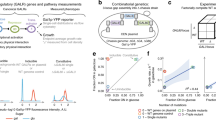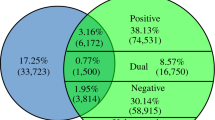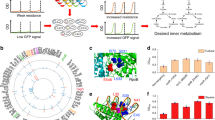Abstract
Transcriptional noise is known to be an important cause of cellular heterogeneity and phenotypic variation. The extent to which molecular interaction networks may have evolved to either filter or exploit transcriptional noise is a much debated question. The yeast genetic network regulating galactose metabolism involves two proteins, Gal3p and Gal80p, that feed back positively and negatively, respectively, on GAL gene expression. Using kinetic modeling and experimental validation, we demonstrate that these feedback interactions together are important for (i) controlling the cell-to-cell variability of GAL gene expression and (ii) ensuring that cells rapidly switch to an induced state for galactose uptake.
This is a preview of subscription content, access via your institution
Access options
Subscribe to this journal
Receive 12 print issues and online access
$209.00 per year
only $17.42 per issue
Buy this article
- Purchase on Springer Link
- Instant access to full article PDF
Prices may be subject to local taxes which are calculated during checkout





Similar content being viewed by others
References
Blake, W.J., Kærn, M., Cantor, C.R. & Collins, J.J. Noise in eukaryotic gene expression. Nature 422, 633–637 (2003).
Kærn, M., Elston, T.C., Blake, W.J. & Collins, J.J. Stochasticity in gene expression: from theories to phenotypes. Nat. Rev. Genet. 6, 451–464 (2005).
Ozbudak, E.M., Thattai, M., Kurtser, I., Grossman, A.D. & van Oudenaarden, A. Regulation of noise in the expression of a single gene. Nat. Genet. 31, 69–73 (2002).
Raser, J.M. & O'Shea, E.K. Control of stochasticity in eukaryotic gene expression. Science 304, 1811–1814 (2004).
Volfson, D. et al. Origins of extrinsic variability in eukaryotic gene expression. Nature 439, 861–864 (2006).
Becskei, A. & Serrano, L. Engineering stability in gene networks by autoregulation. Nature 405, 590–593 (2000).
Orrell, D. & Bolouri, H. Control of internal and external noise in genetic regulatory networks. J. Theor. Biol. 230, 301–312 (2004).
Brandman, O., Ferrell, J.E., Jr., Li, R. & Meyer, T. Interlinked fast and slow positive feedback loops drive reliable cell decisions. Science 310, 496–498 (2005).
Hasty, J., Pradines, J., Dolnik, M. & Collins, J.J. Noise-based switches and amplifiers for gene expression. Proc. Natl. Acad. Sci. USA 97, 2075–2080 (2000).
Melcher, K. Galactose metabolism in Saccharomyces cerevisiae: a paradigm for eukaryotic gene regulation. in Yeast Sugar Metabolism (eds. Zimmermann, F.K. & Entian, K.-D.) (North Holland, Lancaster, Pennsylvania, 1997).
Peng, G. & Hopper, J.E. Gene activation by interaction of an inhibitor with a cytoplasmic signaling protein. Proc. Natl. Acad. Sci. USA 99, 8548–8553 (2002).
Platt, A. & Reece, R.J. The yeast galactose genetic switch is mediated by the formation of Gal4p-Gal80p-Gal3p complex. EMBO J. 17, 4086–4091 (1998).
Acar, M., Becskei, A. & van Oudenaarden, A. Enhancement of cellular memory by reducing stochastic transitions. Nature 435, 228–232 (2005).
Verma, M., Bhat, P.J. & Venkatesh, K.V. Quantitative analysis of GAL genetic switch of Saccharomyces cerevisiae reveals that nuclearcytoplasmic shuttling of Gal80p results in a highly sensitive response to galactose. J. Biol. Chem. 278, 48764–48769 (2003).
Ruhela, A. et al. Autoregulation of regulatory proteins is key for dynamic operation of GAL switch in Saccharomyces cerevisiae. FEBS Lett. 576, 119–126 (2004).
Biggar, S.R. & Crabtree, G.R. Cell signaling can direct either binary or graded transcriptional responses. EMBO J. 20, 3167–3176 (2001).
Verma, M., Bhat, P.J., Bhartiya, S. & Venkatesh, K.V. A steady-state modeling approach to validate an in vivo mechanism of the GAL regulatory network in Saccharomyces cerevisiae. Eur. J. Biochem. 271, 4064–4074 (2004).
Rosenfeld, N., Elowitz, M.B. & Alon, U. Negative autoregulation speeds the response times of transcriptional networks. J. Mol. Biol. 323, 785–793 (2002).
de Atauri, P., Orrell, D., Ramsey, S. & Bolouri, H. Evolution of 'design' principles in biochemical networks. IEE Proc. Sys. Biol. 1, 28–40 (2004).
Orrell, D. et al. Feedback control of stochastic noise in the yeast galactose utilization pathway. Physica D. 217, 64–76 (2006).
Brachmann, C.B. et al. Designer deletion strains derived from Saccharomyces cerevisiae S288C: a useful set of strains and plasmids for PCR-mediated gene disruption and other applications preference. Yeast 14, 115–132 (1998).
Dilworth, D.J. et al. Nup2p dynamically associates with the distal regions of the yeast nuclear pore complex. J. Cell Biol. 153, 1465–1478 (2001).
Scholz, O., Thiel, A., Hillen, W. & Niederweis, M. Quantitative analysis of gene expression with an improved green fluorescent protein. Eur. J. Biochem. 267, 1565–1570 (2000).
Ostergaard, S., Olsson, L. & Nielsen, J. Metabolic engineering of Saccharomyces cerevisiae. Microbiol. Mol. Biol. Rev. 64, 34–50 (2000).
Guarente, L., Yocum, R.R. & Gifford, P.A. GAL10–CYC1 hybrid yeast promoter identifies the GAL4 regulatory region as an upstream site. Proc. Natl. Acad. Sci. USA 79, 7410–7414 (1982).
Rao, C.V. & Arkin, A.P. Stochastic chemical kinetics and the quasi-steady-state assumption: Application to the Gillespie algorithm. J. Chem. Phys. 118, 4999–5010 (2003).
Ramsey, S., Orrell, D. & Bolouri, H. Dizzy: Stochastic simulations of large-scale genetic regulatory networks. J. Bioinform. Comput. Biol. 3, 437–454 (2005).
Gasch, A.P. et al. Genomic expression programs in the response of yeast cells to environmental changes. Mol. Biol. Cell 11, 4241–4257 (2000).
Pédelacq, J.-D., Cabantous, S., Tran, T., Terwilliger, T.C. & Waldo, G.S. Engineering and characterization of a superfolder green fluorescent protein. Nature Biotech. 24, 79–88 (2006).
Lue, N.F., Chasman, D.I., Buchman, A.R. & Kornberg, R.D. Interaction of GAL4 and GAL80 gene regulatory proteins in vitro. Mol. Cell. Biol. 7, 3446–3451 (1987).
Acknowledgements
We thank D. Hwang for helpful advice on the statistical analysis, H. Kostner for assistance with the QPCR experiments and E. Schweighofer for assistance with the cluster computing infrastructure. This work was supported in part by grants from the US National Institutes of Health (GM076547, GM067228).
Author information
Authors and Affiliations
Contributions
S.A.R., J.J.S., D.O., H.B. and J.D.A. designed the study. J.J.S., M.M. and T.W.P. carried out the experimental validation. S.A.R., D.O. and P.A. performed the modeling and simulations. S.A.R., J.J.S., H.B. and J.D.A. wrote the paper.
Corresponding authors
Ethics declarations
Competing interests
The authors declare no competing financial interests.
Supplementary information
Supplementary Fig. 1
Control experiments. (PDF 70 kb)
Supplementary Fig. 2
Analytic model of galactose import. (PDF 25 kb)
Supplementary Fig. 3
Simulated distribution of the number of molecules of Gal80p homodimer within the nucleus, for a cell population of wild-type and mutant strains grown on raffinose (noninducing media). (PDF 42 kb)
Supplementary Fig. 4
Steady-state galactose dose-response. (PDF 63 kb)
Supplementary Fig. 5
Simulated growth of wild-type and mutant strains on alternating galactose and raffinose media. (PDF 55 kb)
Supplementary Table 1
Fractional activity level of the reporter at 6 h, for the wild-type and mutant strains on different initial concentrations of galactose. (PDF 10 kb)
Supplementary Table 2
Oligonucleotide primers used in strain construction and in QPCR measurement of GAL3 and GAL80 expression levels. (PDF 18 kb)
Rights and permissions
About this article
Cite this article
Ramsey, S., Smith, J., Orrell, D. et al. Dual feedback loops in the GAL regulon suppress cellular heterogeneity in yeast. Nat Genet 38, 1082–1087 (2006). https://doi.org/10.1038/ng1869
Received:
Accepted:
Published:
Issue Date:
DOI: https://doi.org/10.1038/ng1869
This article is cited by
-
Independent control of mean and noise by convolution of gene expression distributions
Nature Communications (2021)
-
Metabolic network remodelling enhances yeast’s fitness on xylose using aerobic glycolysis
Nature Catalysis (2021)
-
Damped oscillations in a multiple delayed feedback NF- \(\kappa\) κ B signaling module
European Biophysics Journal (2015)
-
Single yeast cells vary in transcription activity not in delay time after a metabolic shift
Nature Communications (2014)
-
Gene network requirements for regulation of metabolic gene expression to a desired state
Scientific Reports (2013)



